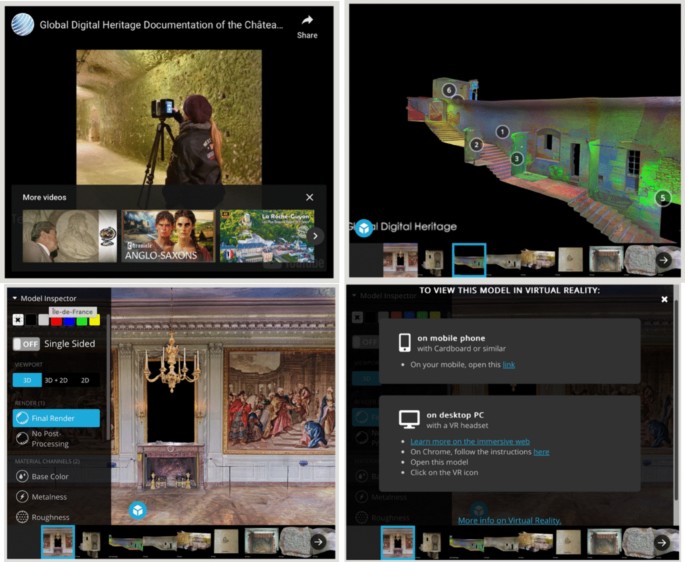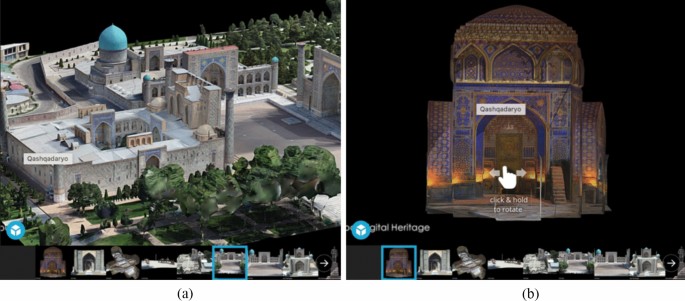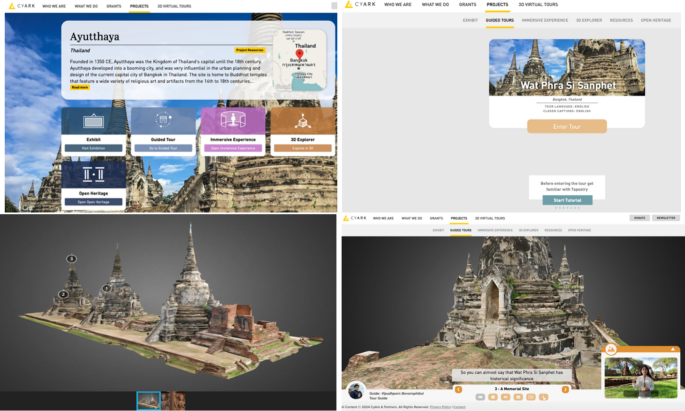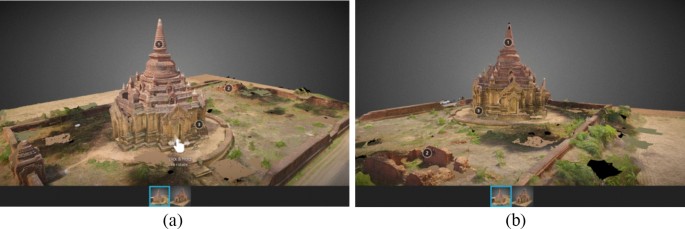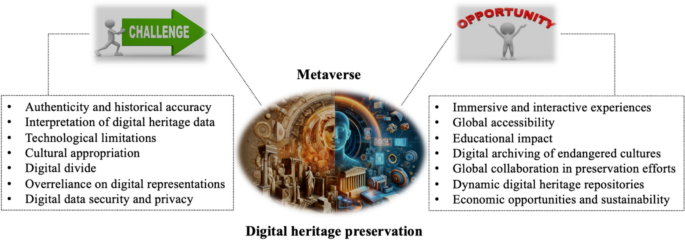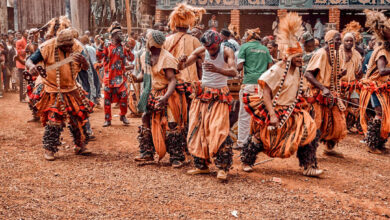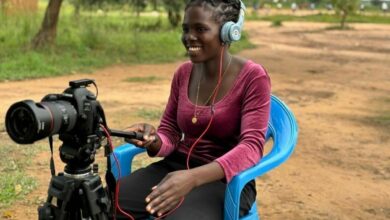Digitalizing cultural heritage through metaverse applications: challenges, opportunities, and strategies
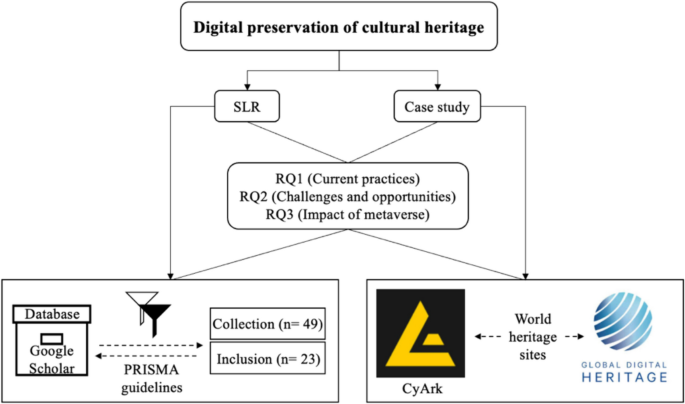
The current study conducted SLR and case study research to investigate current metaverse-based digitalization practices for cultural heritage preservation along with the challenges and opportunities encountered and the impact of metaverse applications in the heritage preservation efforts.
SLR
The current study collected a total of 49 publications from Google Scholar within the publication span of 2020 and 2024. The primary keyword search queries included “cultural heritage”, “tangible cultural assets”, “intangible cultural assets”, “heritage preservation”, “metaverse”, “virtual reconstruction”, and “digital preservation”. The selection process, as shown in Fig. 2 below, involved 49 publications within the span of 2020 and 2024. The inclusion criteria were marked as journal articles and conference papers. The screening phase selected 25 articles from the collected publications excluding books, book series, and reports published before 2020 and non-English publications. The selection process finally included 23 articles in the SLR research after excluding 2 articles for unmatched research scope.
Digitalizing heritage sites: a case study
The current study conducted case study research on the 3D models of some of the world heritage sites designed and developed by Global Digital Heritage and CyArk. It selected four heritage sites inscribed by UNESCO as world heritage sites including Île-de-France in France [24] and Qashqadaryo in Uzbekistan [25] designed and developed by Global Digital Heritage and Ayutthaya in Thailand [26] and Bagan in Myanmar [27] designed and developed by CyArk. Both developers offer various immersive features to virtually visit the heritage sites while emphasizing its global accessibility for free and supporting heritage management, education, and scientific research in digital humanities. Table 1 below shows the documentation methods and 3D technologies used by these developers. They use advanced technologies like LiDAR (Light Detection and Ranging) to scan the heritage sites and landscapes, map them, and model them in three-dimensional environments to create high-resolution data. This LiDAR data is further integrated into VR platforms to create immersive experiences for virtual walkthroughs or experiences that allow users to explore heritage sites virtually. Various VR headsets can also be integrated to optimize these virtual tours. The development and maintenance of these digital heritage sites and archives involve teams of experts from varied fields including archaeologists, researchers, photographers, national tourism authorities, local administrative councils, and local communities. Organizations like UNESCO, National Geographic Society, and institutions of higher education and research are also involved in these collaborations. The collaborative teams not only work to develop and update the digital heritage preservation activities but also initiate and organize field workshops – virtual or on-site – to train the local communities and individuals on various operations like advanced equipment functionality, data documentation, data processing, and 3D modeling.
These digital models are used for education, conservation planning, and to ensure that the sites are preserved for future generations. The digital visualizations of the heritage sites developed by these organizations are an embodiment of documenting, monitoring, and preserving that heritage which is made freely available worldwide for supporting cultural heritage, heritage management, education, public access, scientific research, and enhancing the digital humanities. Details of these case studies are discussed below.
Île-de-France, France
Île-de-France is a region of historical significance in the north-central France. Also known as the Paris region, it produces about one-third of the total GDP of France and consists of eight administrative departments. While boasting of rich historical and cultural sites including the palaces of Versailles and Fontainebleau, the region is a major tourist hub attracting millions of visitors from across the world every year. UNESCO has inscribed the region under world heritage sites in 1979, 1981, 1991, and 2001 [28] which included the palace and park of Versailles, palace and park of Fontainebleau, banks of the Seine in Paris, and Provins (the town of medieval fairs) respectively. Global Digital Heritage has developed its digital preservation by including various information details categorically under a) video (heritage documentation videos), b) collection (3D models of heritage assets to be viewed using different model settings, AR, and VR), and c) heritage sites (with featured pieces in 3D, Google map, and images). Some of the 3D visualizations are shown in Figs. 3a–d below.
a Heritage documentation videos, b 3D modeling of Château de La Roche-Guyon, c 3D model settings, d VR visualization options [24]
As shown in the figures, online visitors can choose from a wide array of setting options to view these heritage sites in a 3D immersive environment. The details would help visitors not only navigate the landmarks and historical sites by exploring their intricate details through virtual environments but also gain their educational insights and historical contexts, thereby making the virtual visit more engaging and informative.
Qashqadaryo, Uzbekistan
Qashqadaryo is a region in southeastern Uzbekistan, which is known for its historical sites and natural landscapes. The region is culturally rich, which has the city of major tourist attraction Shakhrisyabz—the birthplace of the fourteenth century Turco-Mongol emperor and founder of the Timurid Empire Amir Timur. It was inscribed as a UNESCO World Heritage Site in 2000 [28]. Other significant historical buildings of the city include the mausoleums of Mubarak Mervazi built in the fourteenth century and Hazrat Sultan from the twelfth-thirteenth century. Similar to the categorical details of Île-de-France shown in Figs. 3a–d, the virtual visualization of Qashqadaryo involves the same categories with different setting options of its 3D models. Some of the 3D visualizations of the Qashqadaryo region are shown in Figs. 4a–b below.
a 3D model of Registan Complex, b 3D model of prayer hall [25]
Ayutthaya, Thailand
Ayutthaya, or Phra Nakhon Si Ayutthaya, is the historic capital of the Siamese state of Ayutthaya Kingdom (1351–1767) in Thailand. It is known for its impressive architecture, including grand temples and palaces, and its art and literature although much of its architecture and art are lost now. The site of Ayutthaya has been recognized as a UNESCO World Heritage Site for its historical and architectural significance in 1991 [28]. CyArk has developed the immersive visualization environments for users to virtually visit Ayutthaya with an array of visualization options including immersive and 3D tours, as shown in Figs. 5a–d below.
a Immersive display features, b Guided tour features, c 3D model, d Virtual tour with guide [26]
As shown in the figures above, the virtual tours of each project begin with an introductory note on the heritage site, its history and geographical details, and documentation details, and location details on Google Map. The Exhibit tab offers detailed information on the heritage site, its historical context and significance, and its present status along with video documentation details of the project planning and execution. The Guided Tours tab provides a virtual tour of the heritage site with a tourist guide along with a hands-on tutorial on the use of the visualization options like navigation, multimedia controls, and image gallery and videos. The Immersive Experience tab offers a virtual visualization of the heritage site in VR using any of the VR headsets of HTC Vive, Oculus Go, and Oculus Rift with downloadable options, along with historical details and videos on the VR experience. The 3D Explorer tab enables users to conduct a virtual tour of the site in 3D whereas the Open Heritage tab provides information details on the spatial data of the site. In other words, the digital preservation of the heritage site recreates it and allows its virtual visitors to explore it in a 360-degree visualization.
Bagan, Myanmar
Bagan is the historic capital of the Pagan Kingdom (ninth-thirteenth century) now located in the Mandalay region of Myanmar. Being a significant cultural and religious center, the city is renowned for its remarkable array of Buddhist art and architecture, particularly its temples, pagodas, and monasteries, showcasing around 2000 remaining of over 10,000 monuments. These structures are notable for their diverse sizes, scales, and designs, and many contain inscriptions, murals, and sculptures that provide insights into the religious and cultural practices of the time. The Bagan Archaeological Zone was inscribed as a World Heritage Site by UNESCO in 2019 [28], which is also a major tourist attraction. CyArk has developed 3D visualizations of these monuments with the features similar to that of Ayutthaya, as shown in Figs. 6a–b below.
a–b Bagan on 3D Explorer [27]
These case studies demonstrate the diverse ways in which the metaverse technologies are being used to preserve and share cultural and heritage sites, providing immersive and accessible experiences for people around the world.
Addressing RQ1—current practices
Technology is evolving and empowering digital tools to conserve historical and cultural treasures in the best possible ways. Different advanced technologies and methodologies are currently being used, as in the cases discussed in this study, for creating accurate and immersive virtual replicas of cultural sites and artifacts, including photogrammetry, 3D scanning, and various digital modeling techniques [11, 12]. Photogrammetry is a technique of taking multiple photographs of an object or site from different angles and combining them to create a detailed 3D model. It is particularly used for capturing the surface details of artifacts and structures through high-resolution or VR cameras or drones [29, 30]. Advanced 3D scanning technologies like LiDAR use light or lasers to capture the shape and dimensions of objects in three dimensions to create highly accurate digital replicas or models [31, 32]. As discussed in the case studies earlier, LiDAR is a common and powerful tool for virtually preserving cultural heritage. Being a non-contact technology, LiDAR can be used to survey and measure heritage sites without touching or disturbing them, which is crucial for fragile or inaccessible sites. This is why most of the digital documentation processes use 3D scanning tools and processes to digitally conserve a heritage site or artifact. Digital modeling is also used for research and education of the heritage assets. For conservationists and researchers, these digital models serve as a valuable resource enabling them to monitor changes and deterioration of the sites and artifacts over time as well as restore or reconstruct lost or damaged parts of heritage sites. Technologies like AR, VR, AI, and machine learning are increasingly being used to analyze and interpret data from photogrammetry and 3D scanning in terms of identifying patterns, predicting deterioration, and suggesting conservation strategies [33, 34]. These technologies play critical roles in the preservation and conservation of cultural heritage as shown in Table 2 below.
The combination of these advanced technologies and methodologies enables the creation of accurate and immersive virtual replicas of cultural sites and artifacts, contributing to their preservation and accessibility for future generations. In this context, the LiDAR data through VR platforms can be an invaluable educational tool that provides access to remote or restricted sites and can help to raise awareness and appreciation of cultural heritage. Researchers can use such datasets to analyze architectural features, study site layouts, and understand historical landscapes without the need for physical excavation. This can lead to new discoveries about past civilizations without the risk of damaging any of the structures. In the light of this discussion, advanced preservation technologies are an integral part of heritage preservation as they can offer innovative ways to capture detailed, accurate data while preserving the integrity of cultural heritage sites.
Addressing RQ2—challenges and opportunities
Challenges
While the metaverse offers innovative ways to preserve and experience cultural and heritage sites, there are several risk factors and concerns that need to be addressed. It is crucial that the authenticity and historical accuracy of virtual representations of cultural heritage assets be ensured. Conservators often encounter ethical dilemmas, such as the balance between preserving an artifact’s original integrity and the need for restoration, which require interdisciplinary approaches integrating history, archaeology, ethics, and material science to inform conservation practices [2, 3]. When using advanced technologies like 3D modeling and VR to create the digital replicas of heritage sites and artifacts, there is a risk that simplifications or inaccuracies in virtual models might misrepresent the cultural or historical context, which would possibly lead to a distorted understanding of the heritage [35, 36]. One of the critical concerns is the loss of details, especially when digital models may not capture all the traces of the original artifacts or architecture due to incomplete data or limitations of the current technology [31]. Such details can include textures, colors, materials, and small but culturally significant aspects, leading to a less accurate representation. Interpretation of data is also significant in creating digital models, which can be influenced by the creators’ personal, cultural, or academic biases [46]. For instance, informed decisions on feature highlights or ignorance can be influenced by the creators’ own choices or preferences, which can subtly alter the perceived significance of the site. While technology plays a crucial part in cultural heritage preservation, technological limitations can affect the accuracy of digital replication of heritage sites. For instance, the interplay of light and shadow over the course of a day or the aging of materials over centuries can affect how realistically these sites are portrayed in virtual environments [47]. Further, adequacy of digital models can also become questionable in terms of the broader context of a heritage site, such as its geographical setting, its relationship to surrounding buildings or landscapes, and its historical evolution over time [48]. Such contexts are instrumental in developing the understanding and cultural knowledge of virtual visitors about the significance and purpose of a heritage site. This also can contribute to adverse educational impact particularly if these digital models are used as educational tools in schools or museums. Inaccuracies can perpetuate myths or incorrect facts, which might be difficult to correct later. Therefore, it is significant for creators and developers of digital replication and recreation for cultural heritage preservation to aim for and ensure highest possible accuracy with comprehensive data, expert engagement, and latest technology applications. This should also involve community participation for respectful and accurate interpretations and representations of the heritage sites or artifacts.
A sense of cultural sensitivity is paramount when dealing with virtual representations of cultural heritage. It also entails a strong sense of respect for the cultures and communities these cultural assets represent. However, there is a risk of cultural appropriation or misrepresentation if proper consultation and collaboration with local communities are not undertaken [49]. Cultural appropriation occurs when elements of a culture are taken out of context, typically by another culture, and used in a way that does not respectfully acknowledge their original meaning or give credit to their source communities. In virtual environments, this could manifest as using cultural symbols, practices, or artifacts in ways that are seen as disrespectful or trivializing their cultural significance [50]. No involvement of local communities and cultural experts in virtual heritage preservation can misrepresent the heritage sites and artifacts leading to a distorted understanding of the culture effecting stereotypes or even misinformation about the cultural practices of the communities involved. Cultural sensitivity also entails the consultation and collaboration initiatives with local communities and experts for respecting cultural values and representing with accuracy [51]. Further, this sensitivity is associated with ethical implications in how cultural data is collected, used, and shared. Not resonating with the cultural narratives of the communities and their use of the cultural heritage can lead to crucial concerns regarding intellectual property rights and the commercial use of cultural representations [52]. In the light of this discussion, maintaining cultural sensitivity in virtual representations of cultural heritage requires a commitment to authenticity, respect, and ethical engagement with the source communities. Moreover, proper consultation and collaboration are key to avoiding cultural appropriation and misrepresentation.
Another serious concern is that of digital divide. Since metaverse is relatively new, access to the metaverse and virtual reality technologies is not universal, and there is a risk that the digital divide could exclude certain groups from experiencing virtual cultural heritage. Metaverse and other immersive technologies often require expensive hardware, such as VR headsets, and a high-speed Internet connection [37]. These costs can be prohibitive for individuals and communities in lower socioeconomic brackets, potentially excluding them from accessing virtual cultural heritage experiences. Particularly, urban areas are more likely to have the necessary infrastructure and connectivity to support such technologies compared to rural areas [53]. This geographic disparity can prevent individuals in remote regions from accessing these digital experiences, further entrenching regional inequalities. More importantly, the concept of digital divide resonates with that of digital literacy as metaverse applications often require a certain level of digital literacy [54]. Lacking it can be a barrier for older populations or those without formal education in technology. Without the skills to navigate these platforms, some individuals may be unable to benefit from virtual cultural heritage. Further, there is also a risk that virtual heritage experiences might not be designed to reflect the cultural realities or languages of diverse global communities [55]. This could alienate users who do not see their identities or histories accurately represented. Therefore, efforts are needed to ensure that these technologies are accessible to a diverse range of users. In this case, governments and organizations can emphasize on subsidizing 3D and advanced technologies along with broadband access for educational and relevant institutions [56]. Libraries, community centers, and schools could provide public access to VR equipment and dedicated spaces for experiencing virtual cultural heritage. Implementing programs to boost digital literacy specifically targeted at using metaverse and other immersive platforms can help more people take advantage of these technologies. Moreover, integrating multilingualism and cultural inclusivity with digital cultural heritage experiences can help engage a broader and diverse audience [57].
While virtual preservation is valuable, it should not replace the conservation of physical heritage sites. There is a concern that reliance on digital representations might lead to neglect of the actual sites, which are important for their historical, cultural, and environmental value [57]. Digital models cannot completely capture the context and environment of a site. The atmosphere, surrounding landscape, and sensory experiences—such as sounds, smells, and tactile interactions—are integral to the full appreciation of heritage sites. These elements can be diminished or lost in the virtual environment. Virtual tours could impact economic efforts needed for ongoing physical conservation efforts, which could lead to deterioration of the sites over time [58]. It could also experience educational and emotional impact. For instance, the tangible experience of being at a site, understanding its scale, and seeing firsthand the materials and craftsmanship cannot be fully replicated by digital experiences [59]. Further, environmental impacts are also relevant that can change the physical heritage sites over time due to natural or human-induced factors. Continuous physical conservation efforts are necessary to manage these changes and protect the site from potential environmental damage. Relying solely on digital preservation could ignore the need for environmental management. In other words, digital preservation cannot fulfill the demands of physical conservation of heritage sites [60]. Therefore, digital initiatives should be considered as an additional tool for heritage conservation and not a substitute for its physical conservation. Use of digital tools should complement and not replace physical visits to the heritage sites. This further necessitates community or public education on the importance of conserving the physical aspects of heritage sites, ensuring they understand that digital replicas are supplements, not substitutes.
The concerns of data security and privacy are equally important in digital heritage preservation, particularly when advanced technologies like metaverse applications are involved in the process. Since accuracy of representations affects historical understanding, there is a risk of data tampering or corruption, either maliciously or accidentally, which could lead to misrepresentations of cultural artifacts or sites. In terms of digital repositories, there is a risk that unauthorized individuals could access and use heritage data for purposes other than those intended, such as commercial exploitation without proper attribution or consent [61]. This could lead to legal and ethical issues, especially with sensitive or sacred cultural materials. This also involves concerns of intellectual property rights as to who owns the data and how to use or authorize its use, share, store, and reproduce the data, which could potentially lead to misuse. For living cultures, digital representations may include sensitive information about current-day individuals or communities that consider certain knowledge, practices, or sites to be private or sacred. Therefore, data handling with respect to cultural norms and privacy expectations is essential. Securing long-term access to and preservation of digital data is another challenge. Digital formats can become obsolete quickly, and maintaining the necessary technology infrastructure to support ongoing access and compatibility can be costly and technically challenging. Data storage systems are also subject to cybersecurity risks. Hackers could target these repositories for theft, ransom, or simply to cause damage. These challenges require careful planning and robust technical, legal, and ethical frameworks to ensure that digital heritage preservation efforts using metaverse and other advanced technologies are secure, respectful, and sustainable. Addressing these concerns requires a collaborative approach involving technologists, cultural heritage professionals, communities, policymakers, and educators. By considering these factors, the potential of the metaverse to preserve and share cultural heritage can be realized in a responsible and inclusive way.
Opportunities
The metaverse holds significant potential for cultural and heritage preservation in the near future, with advancements in technology and increased global connectivity paving the way for new opportunities. One of the prominent factors leading to the diffusion of metaverse in recent cultural heritage preservation practices is the COVID-19 pandemic outbreak and its impact causing forced immobility and closure of physical sites [62,63,64]. While it has increased demand for virtual access to these cultural resources, the pandemic has highlighted the potential of the metaverse to reach a global audience through virtual experiences. This further accelerated the integration and application of digital technologies in developing 3D models of artifacts, immersive storytelling techniques, and interactive virtual tours of heritage sites [65, 66]. Technologies like 3D scanning and modeling became crucial tools, allowing for the creation of detailed digital replicas of artifacts and sites, which could be explored in the metaverse, thereby opening more opportunities for the latter. Post-pandemic heritage conservation practices are witnessing not only increased funding for digital initiatives but also more public–private collaborations to create sophisticated virtual environments [67]. Even as lockdowns eased, the interest in virtual cultural heritage experiences remained strong. Many institutions recognized the long-term benefits of maintaining a robust digital presence and continued to invest in the metaverse [68, 69]. The pandemic led to the development of hybrid models that combine physical and virtual experiences, enabling visitors to enjoy augmented reality tours at physical sites or participate in virtual events that complement their in-person visits. In other words, forced immobility of the heritage sites during the pandemic outbreak led to the adoption of digital technologies resulting in enhanced engagement, preservation, and accessibility of cultural heritage [63, 70]. This shift has not only helped navigate the challenges of the pandemic but also set the stage for a future where digital and physical experiences are seamlessly integrated. As VR/AR technologies continue to improve, the metaverse will offer even more immersive and interactive experiences [13]. It can make cultural and historical sites accessible to a global audience, regardless of physical or geographic barriers [53, 71]. This is especially important for sites that are fragile, remote, or otherwise inaccessible, allowing people from all over the world to experience and learn about different cultures and histories without physically traveling to the sites. Users will be able to explore cultural sites and heritage artifacts in ways that closely mimic real-life experiences, with enhanced sensory inputs like haptic feedback and spatial audio. Their engagement and interactivity with 3D reconstructions of heritage sites and artifacts can transform learning and education as well. For instance, virtual heritage experiences can be integrated into school and university curricula, providing students with engaging and interactive ways to learn about history, art, and culture [72]. This can enhance traditional learning methods and foster a deeper appreciation of cultural heritage among younger generations. Many cultural heritage sites are at risk from environmental threats, neglect, or conflict and are endangered or on the verge of it. The metaverse allows for the digital preservation of these sites in meticulous detail. Reconstruction of high-resolution 3D models can archive every aspect of a site and even restore them virtually while ensuring their digital preservation for future generations [73]. Not only tangible assets, metaverse also offers a platform for preserving intangible cultural heritage, such as dance, music, language, and rituals. These cultural expressions can be performed, taught, and experienced in the metaverse, helping to keep them alive and relevant in a modern context.
Metaverse technologies can also facilitate global collaboration in terms of bringing together cultural institutions, historians, archaeologists, technologists, and local communities as it is evident in the case studies discussed earlier. This collaborative approach can lead to more comprehensive and inclusive preservation efforts, leveraging the collective expertise and resources of multiple stakeholders [74]. Moreover, use of such advanced technologies in digital heritage preservation can facilitate documentation processes and archiving techniques. Metaverse can serve as a dynamic repository of detailed scans and models—for instance, the larger and dynamic repositories of the case studies discussed—providing researchers and scholars with robust tools for studying cultural artifacts and sites. This can lead to new insights and discoveries that were not possible through traditional research methods. This dynamicity along with technological innovation can further direct to significant scope of wider accessibility, making cultural and heritage experiences accessible to a global audience, regardless of physical limitations or geographical barriers. This can democratize access to cultural education and promote global understanding and appreciation of diverse heritage [75].
On a broader context, digital heritage conservation through metaverse and other immersive applications can open economic opportunities for local communities. Virtual tourism in the metaverse can provide economic benefits to local communities by promoting their cultural heritage and attracting virtual visitors. This can lead to job creation and sustainable development, especially in regions where physical tourism is limited. This has already been a growing trend across the world, which is not only evolving cultural experiences but also transforming the documentation and archiving ways of the cultural assets [76]. Digital museums and archives in the metaverse can provide more dynamic, interactive, personalized, and engaging experiences for users. These virtual spaces can serve as repositories for cultural knowledge and artifacts, accessible to anyone with an Internet connection. The challenges and opportunities identified and discussed are summarized in Fig. 7 below. As immersive technologies like metaverse continue to advance and evolve, these opportunities will only grow, potentially transforming the field of cultural heritage preservation.
Addressing RQ3—impact
The impact of metaverse and other immersive technologies on cultural heritage preservation is multifaceted, offering both significant benefits and facing critical challenges, some of which were identified, explored, and discussed while addressing RQ1 and RQ2. As reported by the studies, the most significant influences of metaverse applications on digital heritage preservation are identified as educational outreach, global accessibility, and sustainability [53, 74, 75]. Metaverse can be utilized for educational purposes, particularly in making cultural heritage accessible to a wider and diverse audience. This involves studying virtual tours, interactive exhibits, and educational programs within the metaverse. These virtual tours—such as the ones of Ayutthaya and Île-de-France from the case studies—can include 360-degree videos, interactive maps, and virtual walkthroughs of historical locations that may be geographically distant or physically inaccessible to many. This not only makes learning more engaging but also removes the barriers of cost and physical travel. By using the metaverse for these purposes, educators and cultural institutions can provide richer, more engaging learning experiences that highlight the importance of cultural heritage and promote a deeper understanding of global histories and cultures [53]. Advanced 3D technologies can imply customizable learning experiences to meet diverse needs, including different learning styles and languages. Moreover, the state-of-the-art documentation methodologies and preservation techniques within the metaverse can help restore cultures or physical heritage sites at risk of decay or destruction. This digital preservation can further serve as a permanent record and a tool for global awareness and education about endangered cultures and sites.
Such immersive applications further facilitate digital heritage preservation to reach to wider accessibility. Metaverse can virtually transport users to cultural sites and experiences around the world that they might not otherwise be able to visit due to travel limitations or costs [77]. This accessibility ensures that cultural heritage is no longer confined to those who can afford to travel but is available to anyone with Internet access. It can also address concerns related to socioeconomic inclusivity. Institutions and organizations can provide free or low-cost access to cultural and educational content in the metaverse which individuals or communities with limited educational resources can access to learn about and engage with global cultures, thereby enhancing their educational outcomes and cultural understanding [78]. Organizations like Global Digital Heritage and CyArk are involved in such initiatives, offering users enhanced immersive experiences to engage with global cultural heritage.
When digitalizing cultural heritage using immersive technologies like metaverse, two significant considerations are relevant: the environmental impact of digital technologies and the long-term preservation of digital assets [17, 79]. Digital heritage data centers consume a large amount of energy even from non-renewable sources, contributing to carbon emissions and environmental degradation. Hardware production also relies on extracting and processing from various metals and minerals, leading to possible environmental damage, including habitat destruction and pollution. Moreover, rapid technological advancements result in electronic waste or e-waste, which is a significant environmental problem due to the toxic substances it can release along with the challenges involved in recycling electronic components [80]. It can also lead to digital data degradation and technological obsolescence due to various factors including hardware failure, software obsolescence, and file corruption, which eventually poses a risk to the longevity of digital archives [81]. Therefore, sustainable practices are relevant in the digitalization process, including the use of renewable energy to reduce carbon footprints of digital technologies, recycling and reusing of e-waste to minimize environmental impact, implementation of robust data management strategies for regular technology updates and migrations to keep digital assets accessible and intact over time, and use of open formats and standards for digital files to reduce the risk of obsolescence. In the light of this discussion, it is important to note that digitalization of cultural heritage is an effective practice to document and preserve the cultural assets, which uses the latest immersive technologies like metaverse in the conservation initiatives. Most of the conservation processes include advanced technologies like 3D modeling and VR tools within the metaverse to provide enhanced immersive experiences in cultural heritage documentation, preservation, virtual visits, and cultural education. While there are challenges involved, the process of digitalizing cultural heritage can be made more sustainable and effective, ensuring that digital assets are preserved for future generations while minimizing environmental impact and maximizing cultural learning experiences.
Source link

